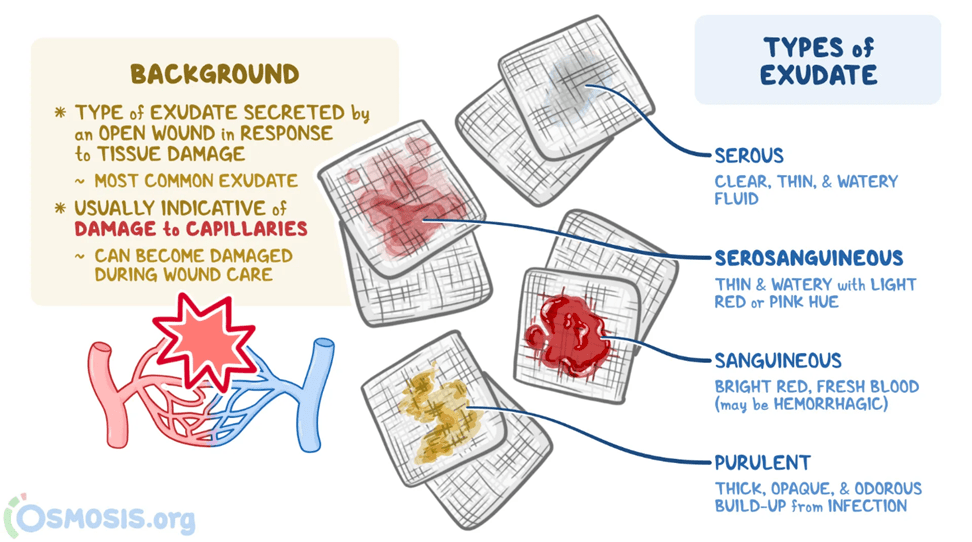
Purulent
adj., [ˈpjʊəɹ(j)ʊlənt]
Definition: consisting of or discharging pus
Table of Contents
The term “purulent” signifies the state of formation and release of pus from a site of inflammation. Thick, foul-smelling, yellowish/off-white/green/brown-colored purulent discharge is not a normal condition and indicates the presence of microbial infection at the inflammation site and needs immediate medical attention.
Purulent Definition
Let us define purulent. The term “purulent” comes from the Latin pūrulentus: ‘pūs’ means ‘pus’ and ‘ulentus’ means ‘containing’. Thus,
- Purulent meaning: containing pus
- Purulent synonym: septic or infected
Now let us understand Purulent – medical definition…
What is a purulent in medical terms? The word ‘purulent’ is used to define a condition or state, that results in pus formation or is filled with pus or that produces/releases pus.
Accordingly, the state can be ‘purulent infection’ or ‘purulent wound’ or ‘purulent inflammation’ or ‘purulent acne’, etc.
So, a ‘purulent infection’ would be an infectious condition wherein there is a pus formation due to microbial infection.
A ‘purulent wound’ would be a wound with pus.
A ‘’purulent acne’ or ‘purulent sore’ would be a pimple/acne/sore with oozing pus.
Note it! Pus as a purulent exudate.
Pus is an exudate. There are many types of exudates and pus is a purulent type of exudate. Read this to learn more about the different types of exudates.

Here it is also important to have an understanding of ‘what is a pus’…
Pus is purulent discharge or purulent drainage. Purulent pus is the yellowish, white, grey, or brownish exudate formed at the site of inflammation due to microbial infection.
The visible accumulation of pus underneath the epidermis is referred to as a pustule or pimple while pus or the purulent material that accumulates within the tissue space is referred to as an abscess.
Pus is basically composed of dead bacterial cells, white blood cells, debris, and inflammatory cells like neutrophils. A foul-smelling purulent drainage might be due to bacterial infection of Pseudomonas aeruginosa.
The white blood cells that die off during fighting an infection get accumulated as white or off-white colored pus. Thus, discharging pus is also indicative of ongoing acute inflammatory processes in the body which has activated the innate immunity of the body.
Watch this vid as an example of purulent acne and the white blood cells present in a pus sample. Caution, this video may be disturbing to watch. Don’t try/popping pimples or acne because it can pose a serious health risk.
The term “purulent” pertains to, describes, is associated with, or promotes purulence. The term purulent is used to describe a condition or entity that promotes pus formation. Both purulent and suppurative are used to describe pus formation. However, others employ purulent and suppurative in a more specific way: purulent is used to describe the pus forming in the affected area whereas suppurative is used to describe the pus oozing from the site of injury or infection.
Examples of Usage
A purulent discharge is not a normal condition and signifies an infectious and/or inflammatory state in the body. Let us understand it with some more examples,
- Purulent pericarditis – it is a lethal cardiac condition wherein there is a pus formation in the pericardium due to an infection in the pericardial space. The infection might be caused by Streptococcus pneumoniae, Staphylococcus aureus, Haemophilus influenzae, viridans streptococci, or anaerobic bacteria.
- Purulent nasal discharge – Yellowish/off-white nasal drainage or discharge is indicative of infection in the upper respiratory tract and bacterial sinusitis.
- Purulent ear discharge – drainage of pus from the ear is indicative of a middle ear infection. There is a build-up of the infection leading to ear pain and pressure build-up. This pressure build-up might lead to the development of perforations in the ear membrane from where the purulent drainage occurs. This condition is also known as otitis media and its treatment involves the usage of antibiotics.
Infection in the outer ear canal might also exhibit purulent ear drainage. Infection of the outer ear canal is also referred to as ‘swimmers’ ears’. Generally in swimmers, there is an accumulation of water in the outer ear canal wherein bacterial or fungal growth occurs which leads to purulent discharge from the ears. - Purulent wound – Drainage from the wound is a normal process, however, there can be different types of discharge from the wound depending upon its healing condition. These wound drainage can be:
- Thin watery liquid, normal wound healing, i.e., Serous drainage
- Presence of a small amount of blood in the liquid, however healthy wound healing, i.e., Serosanguineous drainage
- Presence of blood, i.e., Sanguineous drainage
- Thick, pus-like discharge, i.e., Purulent drainage
Discharge of a small amount of thin watery liquid is indicative of a normal wound healing process. However, the discharge of thick, yellow/green/brown liquid with a foul smell (purulent discharge) indicates an infection in the wound. Thus, a purulent wound indicates an underlying complication in the wound and needs immediate medical attention.
- Purulent conjunctivitis – Discharge of thick yellowish liquid from the eye which can lead to difficulty in opening the eyes in the morning can be due to infectious conjunctivitis. A purulent discharge may lead to the formation of crust on the eye in the morning leading to difficulty in opening it. Streptococcus pneumoniae, Haemophilus influenzae, Staphylococcus aureus, and Moraxella catarrhalis are some of the bacteria that can lead to purulent conjunctivitis.
- Pulent discharge is also seen in neonatal conjunctivitis, wherein blockade of the nasolacrimal duct due to infectious conjunctivitis leads to the release of purulent discharge from the inner corners of the eyes of the neonate.
- Conjunctivitis caused by Neisseria gonorrhoeae which is characterized by edematous eyelids, swollen congested conjunctiva, and purulent discharge is referred to as hyper purulent acute conjunctivitis.
- Purulent vaginal discharge – An yeast infection, i.e., Candida albicans in the vaginal area may result in purulent discharge.
The yellowish color of pus is due to the presence of an antibacterial protein known as myeloperoxidase while the greenish color in the pus is due to the presence of a pigment known as pyocyanin.
Test yourself! Take the quiz on purulent!
References
- Wald E. R. (1991). Purulent nasal discharge. The Pediatric infectious disease journal, 10(4), 329–333. https://doi.org/10.1097/00006454-199104000-00013
- Costa, L., Carvalho, D., Coelho, E., Leal, D., & Lencastre, L. (2021). Purulent Pericarditis: Is It Really a Disease of the Past?. European journal of case reports in internal medicine, 8(7), 002658. https://doi.org/10.12890/2021_002658
- Kenealy, T., & Arroll, B. (2013). Antibiotics for the common cold and acute purulent rhinitis. The Cochrane database of systematic reviews, 2013(6), CD000247. https://doi.org/10.1002/14651858.CD000247.pub3
- Lee, C. Y., Tsai, H. C., Kunin, C. M., Lee, S. S., & Chen, Y. S. (2015). Clinical and microbiological characteristics of purulent and non-purulent cellulitis in hospitalized Taiwanese adults in the era of community-associated methicillin-resistant Staphylococcus aureus. BMC infectious diseases, 15, 311. https://doi.org/10.1186/s12879-015-1064-z
©BiologyOnline.com. Content provided and moderated by Biology Online Editors.








